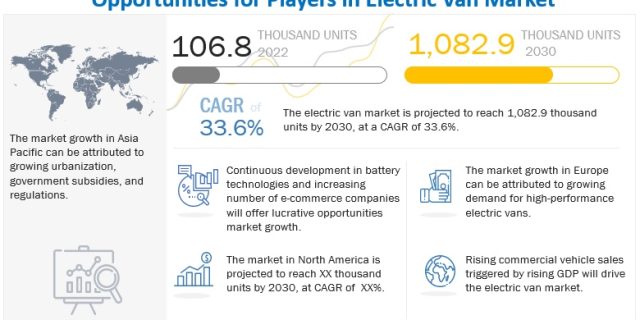
The electric van market is projected to register a CAGR of 33.6% from 2022 to 2030, reaching 1,082.9 thousand units by 2030 from 106.8 thousand units in 2022. The market growth can be attributed to factors such as the increase in distribution services and last-mile delivery and the government’s focus on reducing vehicle emissions.
“By range, 100-200 miles segment expected to lead market during forecast period”
With a growing focus on long-distance transport, the demand for higher-range electric vans is expected to increase. Thus, manufacturers are focusing on introducing electric vans with a 100–200 miles range to cater to the intercity segment. For instance, in June 2022, Renault launched Master E-Tech Electric which is equipped with a lithium-ion battery and a range of 126 miles. In August 2021, Lyreco received 17 Master E-Tech electric vans with a range of 126 miles for delivery purposes in the European region. This range segment of electric vans is expected to witness prominent growth in the future due to the need for a reduction in environmental pollution.
Download PDF Brochure @ https://www.marketsandmarkets.com/pdfdownloadNew.asp?id=100665934
“By propulsion, BEV segment to highest growth rate during the forecast period”
An electric van that runs completely on a battery is termed a BEV. The van runs with the help of a permanent magnet motor powered by a battery installed in the vehicle. Electric motors used in BEVs have high efficiency¯about 90% compared to ICE which is about 30-40%. The average range of BEVs varies based on battery type installation. The vans installed with the BEV propulsion system are generally used for last-mile delivery purposes. Since last-mile delivery is the most common application for electric vans, BEVs are expected to witness strong demand in the near future. Further, the electricity used to power the vans costs less than diesel fuel, which further lowers the operational costs for vans. With advancements in battery technology and a continuous decrease in battery prices, the overall costs of BEVs are expected to decrease in the coming years.
“Europe estimated to account for largest market size during the forecast period”
Europe has stringent emission regulation standards, and governments in this region provide huge incentives to promote electric vehicles. As a result, the demand for electric vans has increased tremendously in the region. The region is home to major manufacturers of electric vans such as Renault, Iveco, LEVC, and Fiat. Europe has set a goal of reducing 80% of CO2 emissions by 2050 as announced by the European Union and has, thus, created a roadmap for the same. In April 2021, DHL Express announced the purchase of 100 E-Ducato electric vans from Fiat to electrify its last-mile deliveries in Europe. The growing charging infrastructure due to rising demand for EV fast-charging infrastructure and the increasing prevalence of range anxiety among EV users are also driving the electric van market.
The key companies profiled in the study are General Motors (US), Renault (France), Toyota Motor Corporation (Japan), BYD (China), Ford Motor Company (US), Nissan Motor Corporation (Japan), Mahindra & Mahindra Ltd. (India), Iveco (Italy), London Electric Vehicle Company (UK), and Fiat (Italy).
Request Free Sample Report @ https://www.marketsandmarkets.com/requestsampleNew.asp?id=100665934
